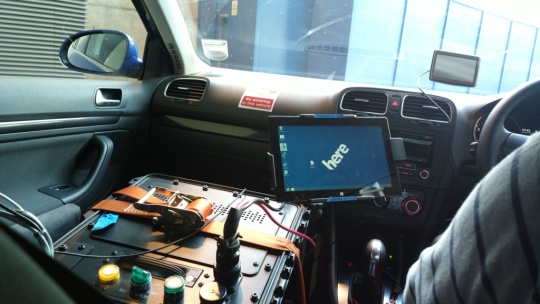This article is more than 1 year old
We go joyriding in the Google Maps-killer's ROBO-CAR
Set the LIDAR to stun, Scotty
Nokia's HERE wants to leapfrog Google's Street View with an ambitious street scanning based on 3D and "big data".
While Google enjoyed a monopoly on street level images for years, having a first move advantage isn't always a blessing. The latest technology allows for much richer and more interactive maps. HERE is deploying hundreds of cars with the new tech.
Surprisingly, and in contrast to the secretive data slurper Google, Nokia wants people to see it and to show off its "Street Level" technology. We took a tootle around Paddington in one of them.

Nokia isn't exactly trying to camouflage its HERE car.
Nokia acquired EarthMine a year ago and the new street scanner has been built around it. The imaging unit consists of four 16.8MP cameras, for 68MP images.
There's also a Lidar unit, with a 2cm accuracy, creating a 3D scatter plot as the car tools around.
Here's the car at rest, with the imaging rig retracted:



The Lidar Unit. Don't worry! There isn't really a man trapped inside. It's just a reflection of a HERE employee.

You don't see an erection like this every day
The car performs optical character recognition on street signs and these are fed back to the map. The idea is to create a 3D digital representation of the city.
Because it's doing much more than taking photos, the system records 140GB of data a day.
HERE says it's only recording the GPS locations of open Wi-Fi hotspots, mindful of the furore in several countries after Google slurped up passwords and web pages that users were browsing. The UK recently ordered Google to destroy the data it had collected, while in the US, Google received a fine (albeit a puny $7m one).
HERE is also working on technology for semi-automated or automated driving. Here's the custom app the drivers uses – to check all four cameras are working.
HERE reckons a significant advantage comes from being a pure mapping outfit, rather than as a filler for a bigger advertising platform, as at Google. It employs 1,200 geographic analysts. It makes 2.7 million changes a day to the map, so it's able to see real-time patterns. And it doesn't need to know who you are, because it's not trying to sell you anything - so the data is anonymous.
The 3D Street Level images should start to show up in HERE maps next year. ®


